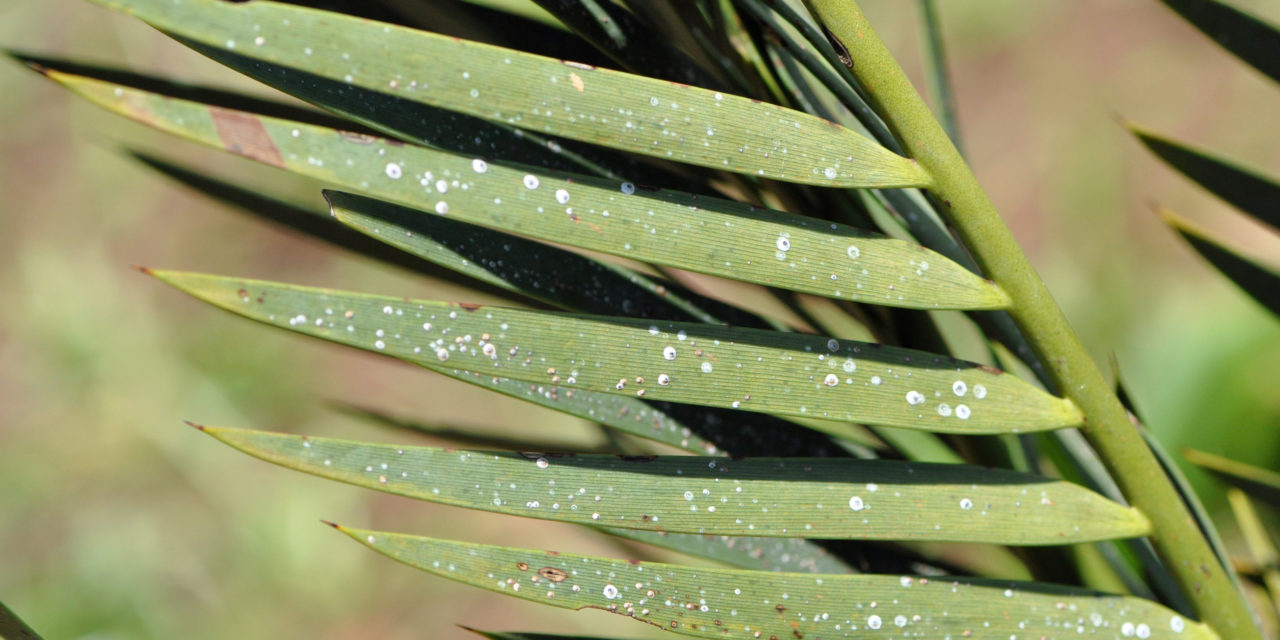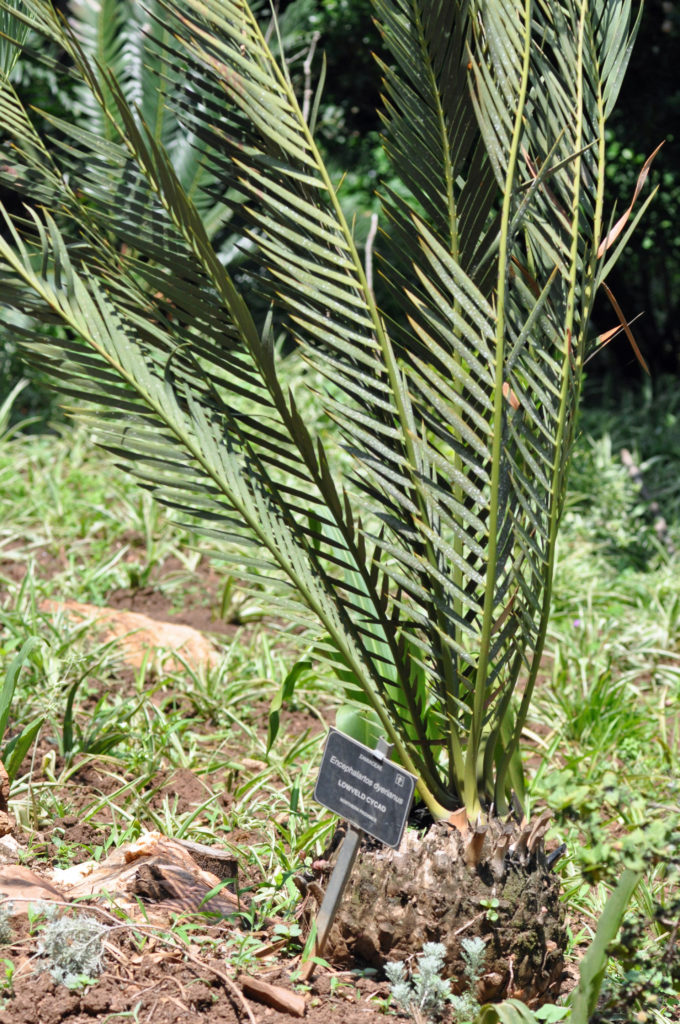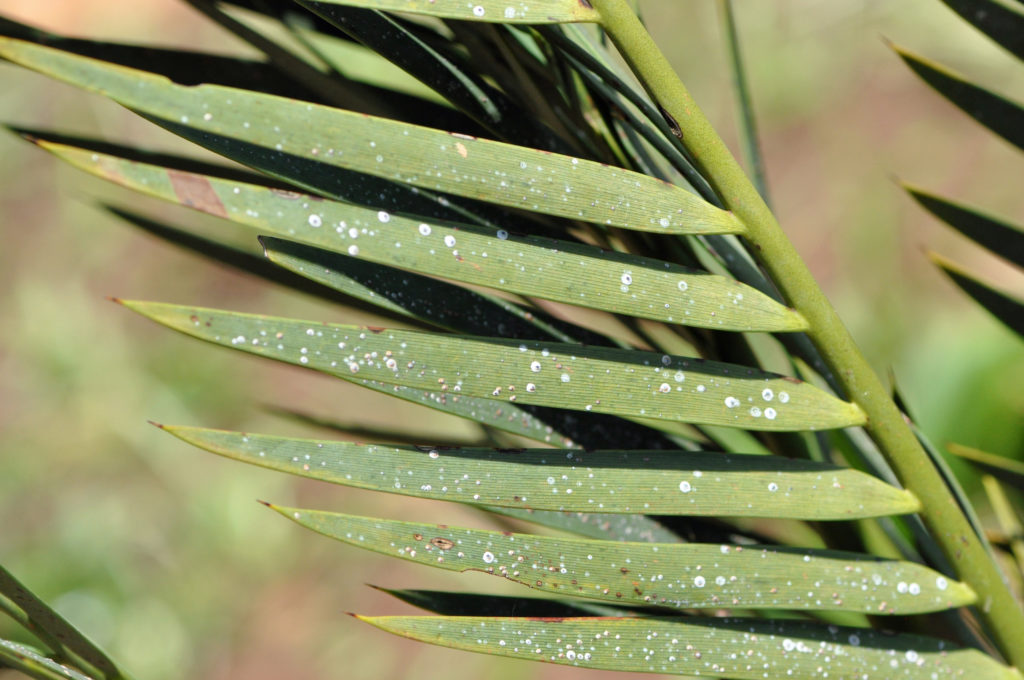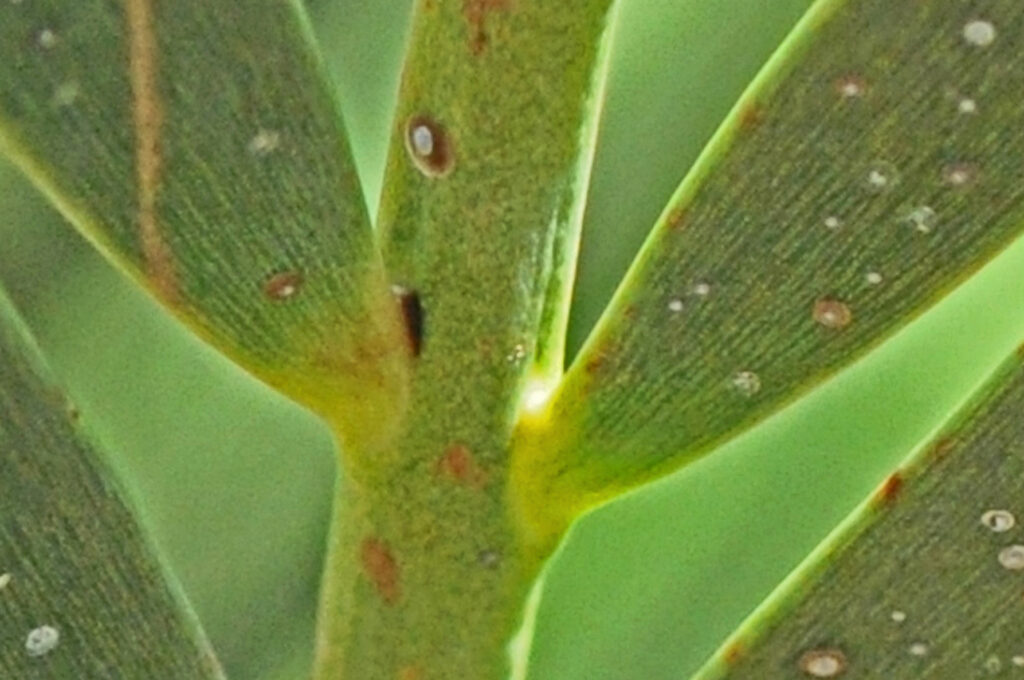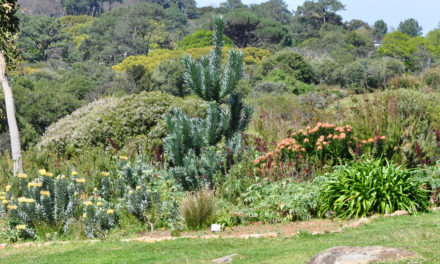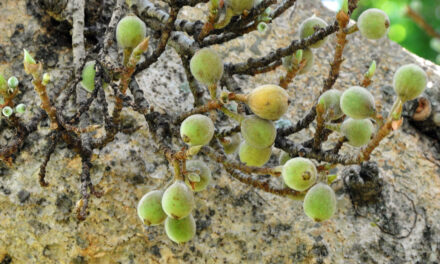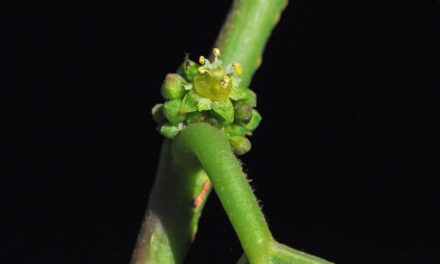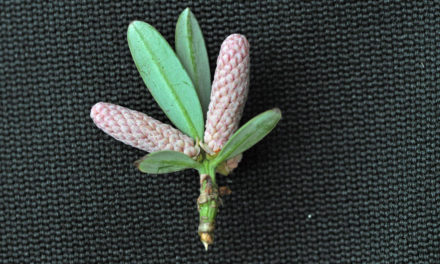General Info – summary
This impressive dioecious Tree is up to 4m high. The pinnately compound Leaves are up to 3,1m long. The non-overlapping, parallel-veined leaflets lack midribs and lowermost leaflets are reduced to prickles. Fallen leaves eventually leave only a leaf scar. The 4-7 male Cones have motile sperm and the 1-5 insect pollinated female cones have naked animal dispersed seeds, which are up to 4 x 3cm.
Description
Encephalartos dyerianus
Previous Name: Encephalartos graniticolus.
SA Tree No. 14.2.
Comparing Gymnosperms (G) and Angiosperms (A). G and A are both Spermatophytes (seeds producers). G seeds are naked (unenclosed), lack flowers (have no ovaries or fruit). In A, seeds develop in flower ovaries. After fertilization, the ovule (egg) becomes a seed, and fruit surrounds the ovaries. In G seeds are usually in cones and become visible when mature cones open. Both G and A have vascular tissue: xylem (water conducting – from roots) and phloem (products of photosynthesis from leaves to the plant). There are far less living species in G (1 000+) than in A (300 000+). G are mainly woody trees and shrubs and only 1 sp. has climbing vines. In A there are many herbs, climbing vines and trees. Conifers (including pines) are the largest group of G.
Common names: (Afr) Broodboom, Lillie-se-broodboom, Lillie-broodboom. (Eng) Lillie’s Cycad, Lowveld Cycad.
Family: Zamiaceae. This family is part of the major group: Gymnosperms. They are usually cone-bearing plants producing naked seeds and include Ginkgo (in China), Cycads, Conifers (e.g., pine trees) and Gnetophytes: e.g., the unique Welwitschia mirabilis (tweeblaarkanniedood) are not wind pollinated and found in the deserts of western Namibia and southern Angola. Members of the gymnosperm family Zamiaceae have no flowers or fruit and the seeds are often contained in Cones. This family has 8 genera, including the Genus Encephalartos, which contains all species of cycads).
Name derivation: Encephalartos – within-head-bread: referring to the starchy bread that can be made from the pith of the inner trunk. dyerianus – named after Allen Dyer (1900-1987) – a prominent researcher in South Africa. He was the director of the Botanical Research Institute from 1944- 1963 and started the Pretoria National Botanical Garden. The African plants in the genus Encephalartos include about 66 species and there are about 30 species in southern Africa. Species of Encephalartos (Cycads) are only superficially palm or fern like and are usually unbranched.
Conservation Status: Critically Endangered. Assessment Date: 2009/10/31. (Assessor J. S. Donaldson). This is due to illegal collecting. 107 plants were removed in January 2008.
Tree
This cycad Trunk is up to 4,5m high and may lean over in tall trees. The trunk has a diameter of up to 60cm. The unbranched trunk may sucker from the base – forming clumps. When each entire leaf falls, the leaf scar is the only part that finally remains on the stem. The cycad tap Root is usually soon replaced by lateral roots, which become woody.
- Photo: David Becking.
Leaves
Leaves of cycads may only resemble palm leaves. Cycads are unique Gymnosperms with evergreen, pinnately compound Leaves (leaflets arranged, like a feather, along either side of the central stalk or Rachis (an extension of the Petiole, the leaf stalk, of a compound leaf that bears the leaflets – photo 698 under Tree). Unlike other members of the family Zamiaceae, the cycads have leaflets that lack a central Midrib or vein (photos 690 & 691).
On this cycad, these moderately keeled, blue-silver green leaves may turn slightly yellow. The leaves are relatively straight and up to 1,3m long. In older leaves, the end may bend slightly. The leaf apex may be slightly twisted or recurved. Leaves are slightly persistent – lasting longer than 1 year. The straight petiole (leaf stalk) is up to 6cm long. The non-overlapping Leaflets (photo 690) are bluish green or silver and almost concolorous (uniform colour) on both sides. Each narrow, leathery leaflet is up to 24 x 2cm and the median leaflets are the largest. The lowest leaflets are reduced to prickles. The hard leaflets do not bend easily, and the sunken Veins are parallel and are clearly visible with a hand lens (photo 691). Stomata (structure utilising 2 guard cells, which, unlike lenticels, can control the gaseous exchange between the plant and the surrounding atmosphere) occur on both surfaces (good hand lens / microscope required). The Margin is entire (with a continuous margin, not in any way indented (photo 690) and may have up to 3 small spines on the side. The base of the Petiole (stalk of a leaf) has a prominent collar. Only leaf scars remain on the trunk once the leaf blade, and finally the petiole fall.
- 690 Photo: David Becking
- 691 Photo: David Becking
Cones
As with all cycads, this plant is dioecious (with male and female cones on separate trees). Cones develop in the centre of leaf whorls and rest on short stalks – 6cm+ long. Between 4 and 7 cylindrical, ovoid blue-green or yellow Male cones develop together, each up to 50 x 12cm. In cycads, all male cones produce motile sperms and are not moved along with a Pollen tube to the egg. Up to 5 Female cones are ovoid (solid egg-shaped that is oval in outline) may develop together, each reaching about 55 x 30cm. They initially develop on stalks at stem ends, are green and turn yellow as they mature. At this point, they heat, open up and release an insect attracting odour. The cone scales are covered with protuberances and turn a greenish yellow. Recent research has indicated that Cycads are insect pollinated. The oval Seeds become scarlet and are about 4,2 x 3cm. At maturity, these unenclosed or naked Seeds are released when the Female cones disintegrate. All seeds produce carcinogenic and neurotoxic glycosides (cycasins). Seeds are poisonous to mammals. Seeds have a fleshy covering, which lasts a short while. Birds eat the gum exuded from the cone.
Distribution & Ecology
These Cycads are Endemic (restricted to a particular geographic location) in South Africa. They can be found on open grassland and shrub land on the slopes of low granite koppies (Granite – an igneous rock that develops underground when silica rich molten rock cools – hence the previous name Encephalartos graniticolus) in Mpumalanga and eastern Limpopo at an altitude of approximately 700m. This cycad may coexist with mopane trees (Colophospermum mopane). These cycads also occur in parts of the Kruger National Park (Mpumalanga). Birds, monkeys and baboons disperse the Seeds. The outer covering of the seeds is consumed and, the seeds left behind. The seeds are thus dispersed. Cycads have Coralloid Roots that contain symbiotic cyanobacteria (blue-green algae) that fix atmospheric nitrogen. Through a process of complex biological pathways, the cyanobacteria convert atmospheric molecular nitrogen into compounds such as ammonia, and amino acids needed by the cycads.
Ethnobotany
This tree is slow growing. Both male and female trees are necessary for seed production. In coastal and inland areas, this species prefers to be in full sun, but can tolerate some shade. For desert areas, this species should be placed in partial sun or filtered light. Plant in a well-drained position e.g., on a slope and avoid excessive moisture. Wear gloves when making contact with the poisonous seeds.
References
Coates Palgrave, M. 2002. Keith Coates Palgrave Trees of Southern Africa. edn 3. Struik, Cape Town.
Donaldson, J.S. 2009. Encephalartos dyerianus Lavranos & D.L.Goode. National Assessment: Red List of South African Plants version 2020.1. Accessed on 2023/04/03.
Lungisani Zondi, Ndiyafhi Muthuhadini and Clara Ntombifuthi Sitoe. 2022. Encephalartos dyerianus. Walter Sisulu National Botanical Garden. Accessed on 2023/04/04.
http://www.iucnredlist.org/details/41886/0
http://plantnet.rbgsyd.nsw.gov.au/cgi-bin/cycadpg?taxname=Encephalartos+dyerianus
http://www.cycadpalm.com/endy.html
http://www.junglemusic.net/Encephalartos_Species/Encephalartos_dyerianus.html
http://biodiversityadvisor.sanbi.org/wp-content/uploads/sanbi-identify-it/plants/encephalartos.htm
http://www.theplantlist.org/browse/G/Zamiaceae/
https://www.diffen.com/difference/Angiosperms_vs_Gymnosperms

